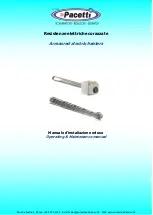
Previous Page
Page 8
Chapter 2, SteamCraft 10 Service Manual
Models 24-CGA-10, 24-CGP-10, 24-CEA-10, 24-CEP-10
• Cleveland Range designs and manufactures equipment
ID
comply with
applicable standards for manufacturers. Included among these certification
agencies are: UL, A.G.A., ASME/N.Bd., NSF, CSA, CGA, ETL, and
others.
• This equipment is designed and certified for safe operation only when
permanently installed in accordance with local and/or national codes. Many
local codes exist, and it is the responsibility of the owner and installer to
comply with these codes.
• In no event shall the manufacturer assume any liability for damage or injury
resulting from installations which are not in strict compliance with the
Installation Instructions and the codes cited above. Specifically, the
manufacturer will not assume any liability for damage or injury resulting
from improper installation of equipment, including, but not limited to,
temporary or mobile installations.
INSTALLATION OVERVIEW
SteamCraft 10 installation is presented in two parts: preparation and instal-
lation. Table 2-1 and Figure 2-1 provide an overview of installation process.
Figure 2-1, Schematic Installation Diagram, illustrates the utility lines and
connections required to install the SteamCraft 10. The Dimension Drawings,
Figure 2-2, show the required utility connection points, dimensions, and
clearances for each of the SteamCraft 10 models.
Table 2-1, Installation Check: List, outlines the overall installation process by
listing, in recommended sequence, the major tasks to be performed. For each
task the table references applicable notes from Figure 2-1 and the manual
pages on which the task instructions begin. Complete the preparation tasks in
sequence, and then the installation tasks. Installation requirements may vary
from site to site; adapt the check list accordingly.
Table 2-1. Installation Check List
(Refer to Figure 2-1)
TASK
FIGURE 2-1
NOTES
PAGE REFERENCE
COMPLETED
Preparation
Check electric power requirements.
1
,2
10
Check gas supply requirements (gas models only).
2,3,4
10
Check exhaust hood requirements.
12
10
Test supply water quality.
5,6
11
Select water treatment system.
6
16
Select operating location-
17
Unpack, inspect, and protect me unit.
18
Installation
Position and level steamer.
11
19
Install and connect drain line.
9,10
20
Install exhaust hood.
12
22
Install and connect electrical line.
1,2
22
Install and connect water supply lines.
5,6,7,8
24
Install water treatment system.
6
26
Test water supply lines.
27
Install and connect gas supply lines (gas models only).
2,3,4
27
Test gas supply lines (gas models only).
28
Bleed gas line at union upstream of gas valve (gas models only)
3
30
Test burner igniter control module (gas models only).
31
Perform final setup and checkout
33
















































